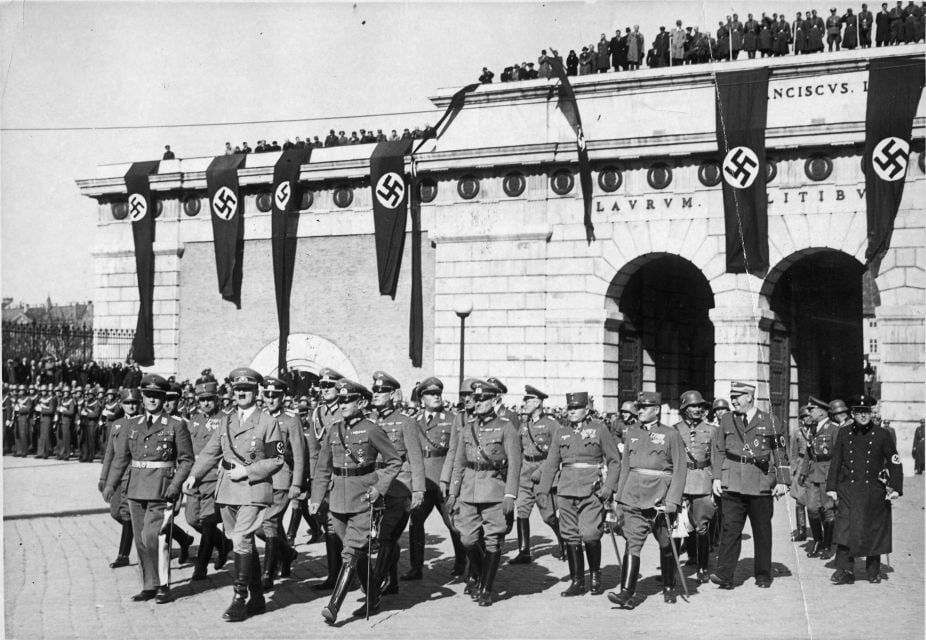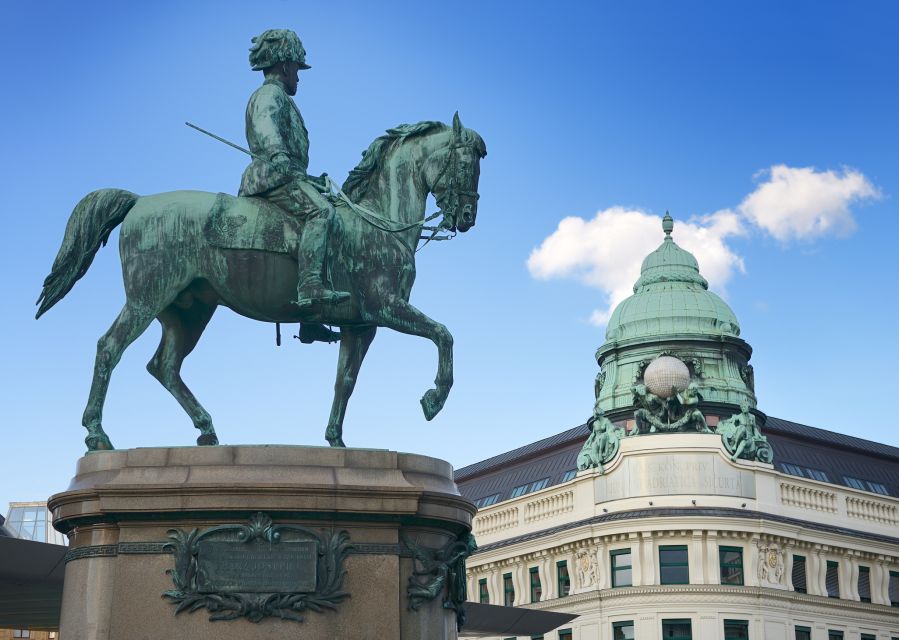Vienna’s tumultuous past during World War II is a captivating chapter in the city’s history. This guided walking tour offers a poignant exploration of the Nazi regime’s impact on the Austrian capital, delving into the rise of Adolf Hitler and the fate of Vienna’s Jewish community. Participants will uncover the physical scars left by the conflict and gain insights into the city’s division among Allied powers. The tour’s immersive experience promises a thought-provoking look at Vienna’s wartime legacy, leaving visitors with a deeper understanding of the resilience that emerged from this pivotal era.
Key Points

- The tour explores the impact of the Nazi regime on Vienna, including the fate of the city’s large Jewish community and visible remnants of the war.
- Highlights the only synagogue that survived the Nazi occupation and the city’s Holocaust memorial, providing a somber tribute to those who perished.
- Examines how Vienna was divided among Allied powers after the war, with lasting effects on the city’s physical landscape and political landscape.
- Provides insights into Adolf Hitler’s early years and the influence of Vienna’s social and architectural landscape on the development of his ideology.
- Offers an immersive experience that combines historical accounts, physical sites, and the city’s resilience in the aftermath of the devastating conflict.
Tour Overview

The 2.5-hour guided walking tour allows visitors to explore Vienna’s influence on Adolf Hitler and the city’s pivotal role during World War II.
Travelers will see historical sights related to the Nazi regime and its impact on Vienna. The tour highlights the only synagogue that survived the Nazi era and Vienna’s Holocaust memorial, providing a poignant look at the city’s wartime scars and the legacy of the divided city after the war.
Along the way, the guide shares insights into Hitler’s early years and ideology, as well as the over 100,000 bombs that impacted Vienna during the conflict and the fate of the city’s large Jewish community under Nazi occupation.
If you're enjoying exploring Vienna on foot, you'll love these other walking tours we recommend
Key Highlights

Visitors on the Vienna World War II Historical Walking Tour can expect to see the only synagogue that survived the Nazi regime and Vienna’s poignant Holocaust memorial, providing a first-hand look at the city’s wartime scars and the lasting impact of the divided city after the conflict.
The tour highlights include:
- Exploring the remains and scars of WWII that are still visible throughout the city.
- Learning about the fate of Vienna’s large Jewish community under Nazi occupation.
Observing how Vienna was divided among Allied powers after the war, with lasting effects.
Discovering the resilience of the city and its ability to rebuild in the aftermath of the conflict.
Tour Route

The Vienna World War II Historical Walking Tour departs from in front of the Albertina Museum, next to the Vienna Opera House, providing visitors with insight into Hitler’s early years and ideology. The tour route covers key historical sights related to the Nazi regime and its impact on Vienna.
| Stop | Attraction |
|---|---|
| 1 | Albertina Museum |
| 2 | Vienna Opera House |
| 3 | Synagogue Surviving the Nazi Regime |
| 4 | Vienna’s Holocaust Memorial |
| 5 | Remnants of the Divided City After WWII |
Throughout the 2.5-hour guided walk, participants learn about the over 100,000 bombs that impacted the city, the fate of Vienna’s large Jewish community, and how the city was divided among Allied powers after the war.
Content and Experiences
Throughout the 2.5-hour guided walk, participants learn about the over 100,000 bombs that impacted the city, the fate of Vienna’s large Jewish community under Nazi occupation, and how the city was divided among Allied powers after the war.
The tour provides a poignant look into this dark chapter of Vienna’s history:
-
Visitors hear first-hand accounts of the horrors experienced by Vienna’s Jewish population, including the destruction of synagogues and persecution of the community.
-
The tour explores how the city’s physical landscape still bears the scars of wartime bombings, with bullet holes and crumbling buildings serving as reminders of the devastation.
-
Participants gain insight into the post-war division of Vienna, learning how the city was carved up and controlled by the Allied powers.
-
The tour culminates at Vienna’s Holocaust memorial, a somber and powerful tribute to those who perished.
Practical Information
The 2.5-hour guided tour is conducted in English by a live guide, and it includes entrance fees to all the highlighted attractions. Participants can also take advantage of the ‘Reserve now & pay later‘ booking option. This allows visitors to secure their spot on the tour without needing to pay upfront, providing added convenience and flexibility.
The walking tour covers important sites related to Vienna’s involvement in World War II, giving guests a firsthand look at the city’s history and the lasting impact of the Nazi regime. With a knowledgeable guide leading the way, attendees can expect an informative and immersive experience as they explore Vienna’s wartime past.
Fascinated by Vienna's past? More historical tours we've covered
Adolf Hitler’s Influence

In his early years, Adolf Hitler spent significant time in Vienna, where he developed many of the ideological foundations that would later shape the Nazi party and its devastating impact on the city.
The walking tour explores how:
-
Hitler’s anti-Semitic views were influenced by the city’s racial tensions and social climate.
-
His failed application to the Vienna Academy of Fine Arts shaped his resentment towards intellectuals and the arts.
The city’s urban planning and architecture reinforced Hitler’s vision of a ‘pure’ Aryan society.
Vienna’s status as the former capital of the Austro-Hungarian Empire fueled Hitler’s desire to restore a pan-German nationalist empire under Nazi rule.
Nazi Regime’s Impact
Under the Nazi regime, Vienna’s Jewish community faced devastating consequences. Over 65,000 Jewish residents were deported and murdered in concentration camps, drastically diminishing the city’s once-thriving Jewish community. The Nazi’s impact was also visible throughout the city, with numerous landmarks and buildings bearing the scars of wartime bombardment. To commemorate this dark period, the tour visits Vienna’s Holocaust Memorial, a powerful reminder of the lives lost. Plus, the tour highlights the only synagogue that survived the Nazi occupation, a symbol of resilience in the face of overwhelming adversity.
| Landmark | Significance |
|---|---|
| Holocaust Memorial | Commemorates the lives lost during the Nazi occupation |
| Surviving Synagogue | Represents the resilience of Vienna’s Jewish community |
| Bombed Buildings | Physical reminders of the city’s wartime devastation |
| Divided City | Reflects the post-war division of Vienna among Allied powers |
| Deported Jews | Underscores the catastrophic loss of Vienna’s Jewish population |
Post-War Division
After witnessing the devastation of the war, Vienna found itself divided among the Allied powers following WWII. The city’s occupation by American, British, French, and Soviet forces led to its partition into distinct zones, reflecting the broader geopolitical tensions of the post-war era.
These zones were responsible for governing their respective areas, leading to a fragmented and complex administrative structure within the city.
The division of Vienna mirrored the broader split between East and West, with the Soviet-controlled zone representing the communist influence and the Western-controlled zones embodying capitalist ideals.
The city’s infrastructure, services, and resources were all impacted by this division, creating challenges for Viennese citizens as they navigated the divided landscape.
Overcoming the legacy of this post-war division would require years of cooperation and negotiation among the Allied powers, shaping Vienna’s recovery and redevelopment in the decades that followed.
Frequently Asked Questions
How Accessible Is the Walking Tour for Individuals With Mobility Issues?
The tour’s accessibility for individuals with mobility issues may vary. Certain sights and walking segments could pose challenges. Visitors should inquire about accessibility accommodations when booking to determine if the tour meets their needs.
Does the Tour Operate During Inclement Weather Conditions?
The tour typically operates rain or shine, as it’s an outdoor walking experience. However, the tour may be modified or canceled in severe weather conditions to ensure the safety and comfort of participants. Guests should dress appropriately for the weather.
Are Restroom Facilities Available Along the Tour Route?
The tour route includes stops at several attractions and historical sites, so restroom facilities are typically available along the way. Guests can inquire with the guide about restroom access during the tour.
Can the Tour Be Customized for Private or Group Bookings?
Yes, the tour can be customized for private or group bookings. Private tours allow travelers to personalize the experience, while group tours offer discounted rates. Flexibility is available to accommodate various group sizes and interests.
What Is the Average Group Size for the Walking Tour?
The average group size for the walking tour is typically small, with groups ranging from 6 to 12 participants. This allows for an intimate and personalized experience during the 2.5-hour guided exploration of Vienna’s WWII history.
Recap
This guided walking tour in Vienna provides a poignant exploration of the city’s pivotal role in the rise of the Nazi regime.
Participants will uncover the fate of Vienna’s Jewish community, understand Hitler’s early life and ideology, and examine the lasting impact of the city’s divided legacy.
This immersive experience offers a powerful look at Vienna’s wartime past and its resilience in the aftermath of the conflict.
You can check if your dates are available here:More Walking Tours in Vienna
More Tours in Vienna
- RAXI (E-Rickschaw) Big Private Vienna Tour
- Alpine Christmas Dream: Hallstatt & St.Wolfgang Private Tour
- Private Unknown Sweet Viennese Tour With Tastings
- World War II History Vienna Old Town Private Walking Tour
- Overview & Architectural Tour: Secrets of the Museumquartier
- Vienna Full Day Private Shore Excursion, Van&Walk
More Tour Reviews in Vienna
- Sightseeing Transfers From Vienna to Salzburg With a 4-Hours Stop in Hallstatt
- Vienna: Melk Abbey and Salzburg Private Trip With Transport
- Take VIP Night Photos in Vienna With A Pro Photographer
- Try Find Your Better Than Us ! Airport Transfer Service in Vienna HTL-APT (Vie)
- Private Transfer Vienna → Salzburg, Hotel-To-Hotel, English-Speaking Driver
- Full Day Private Tour to Budapest in a Luxury Car With Pickup
Not for you? Here's more things to do in Vienna we have recnetly reviewed
- Vienna as Never Seen Before: Hidden Courtyards, Legends and Symbols
- Private Day Trip to Bratislava From Vienna
- Bratislava Day Tour From Vienna With a Local Experienced Guide
- Guided Beer Tasting – the Taste of Regional Manufactures
- Private Salzburg Day Trip From Vienna
- Vienna Airport Arrival Transfer (Airport to Vienna Hotel)
- Full-Day Private Trip From Vienna to Bratislava
- Spa, Wellness & Fitness 1 DAY CARD -The Golden Tree Vienna
- Schönbrunn Palace and Garden Tour
- Hallstatt Small Group Day Trip From Vienna
- Johann Strauss Ball – Summer Edition in Kursalon Vienna
- Vienna Private Airport Transfer
